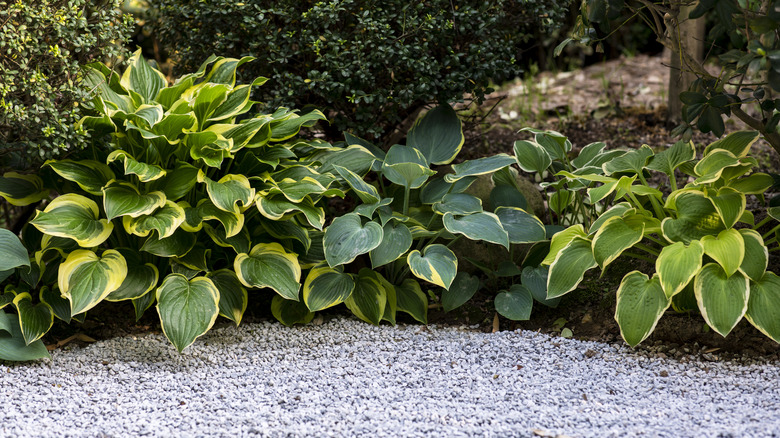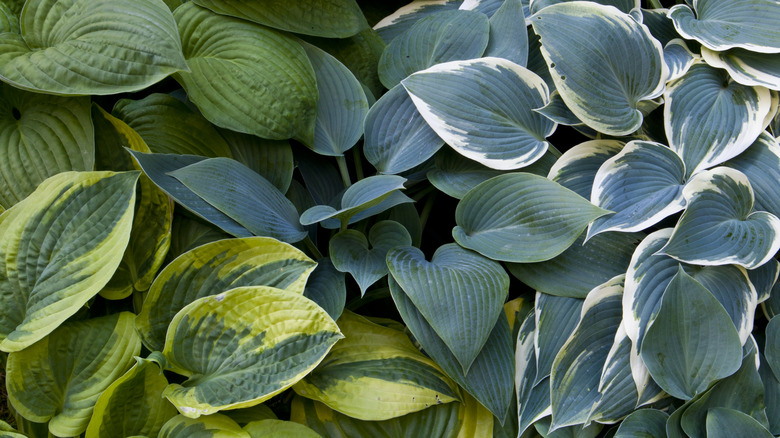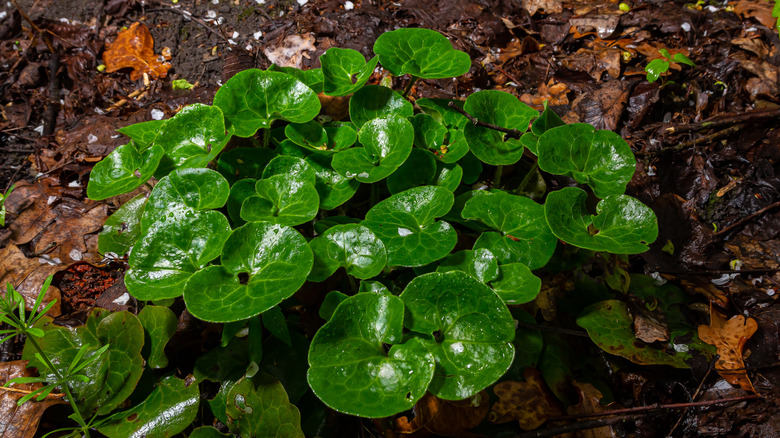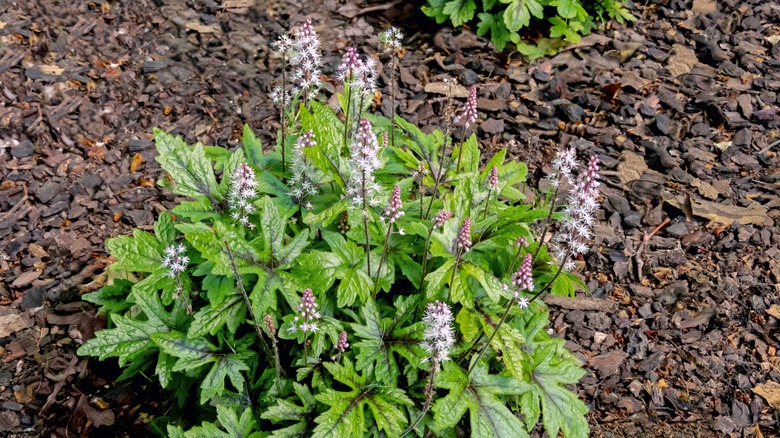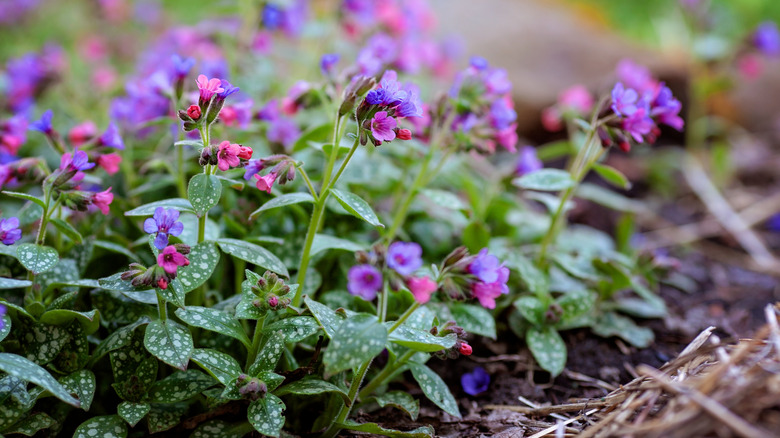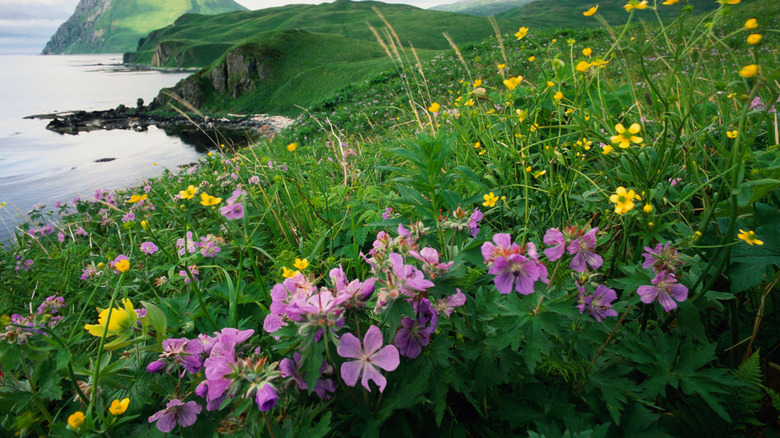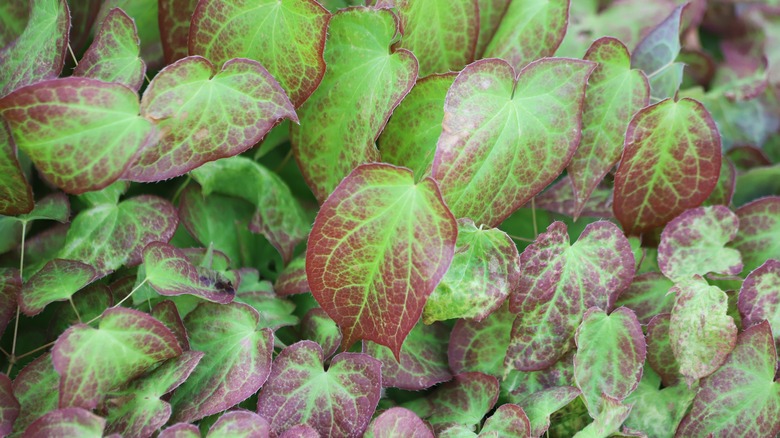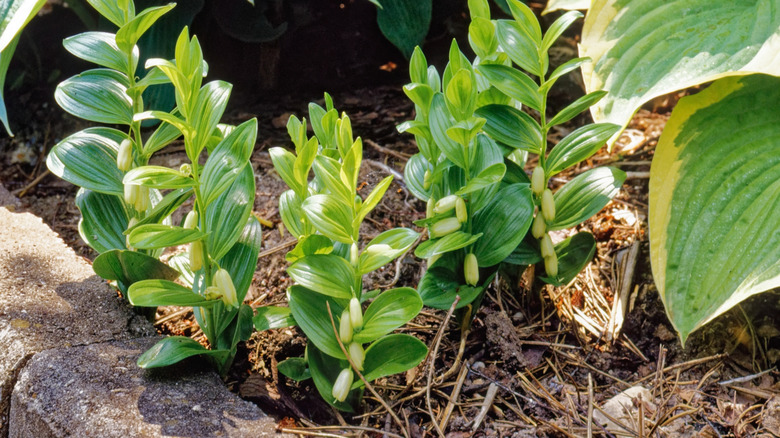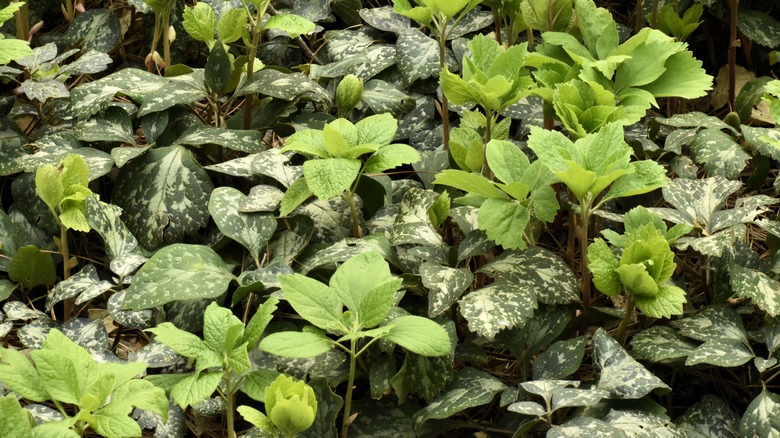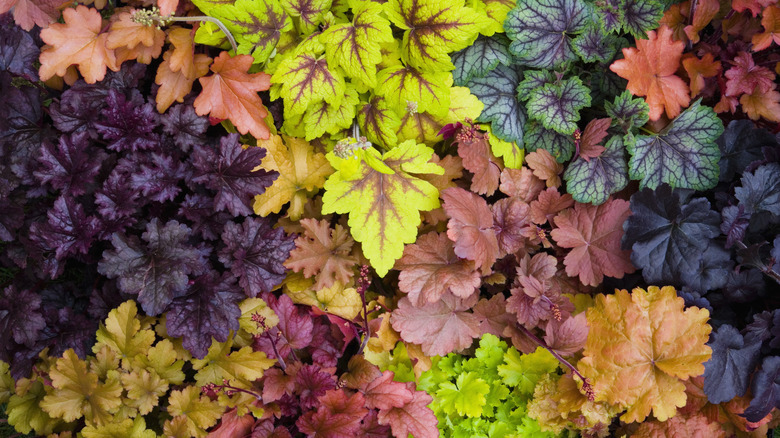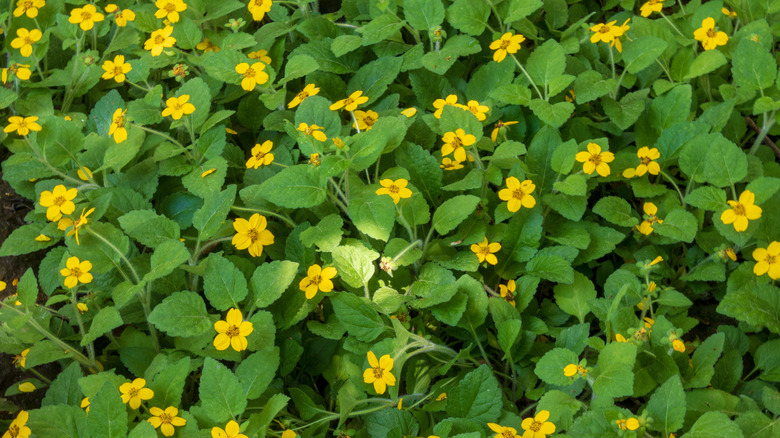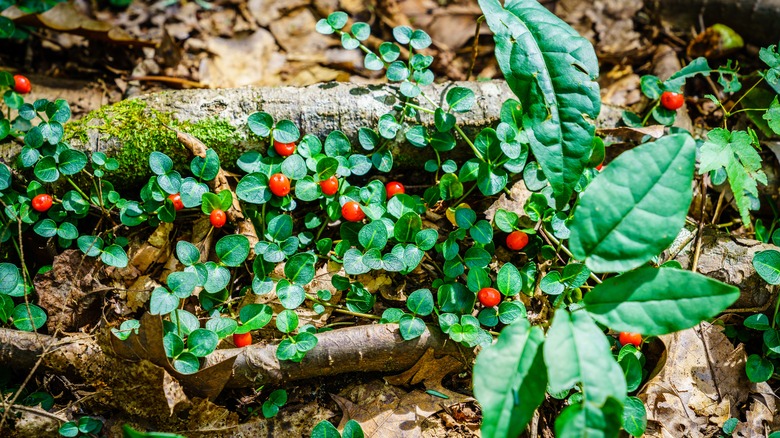10 Stunning Ground Covers That Grow Perfectly With Hostas
Hostas (Hosta plantaginea) are like the tanks of the gardening world. They're one of the hardiest plants you'll find that thrive in conditions that would make other plants wither instantly. Well, not all plants; did you know there are a few foliage friends you can plant with your hostas that will make good neighbors? It's true! We've found 10 amazing ground-covering plants you can plop right next to hostas that will gladly set up shop and cover every bare spot you've got. We'll go over what it is about them that makes them such good hosta BFFs, as well as include some growing tips and fun facts — because who doesn't love talking about hostas at parties?
Okay, maybe we're alone in that, but stay with us. From wild geranium to coral bells, by the end of this article, you're going to find at least one ground cover that's just waiting to be adopted into your landscape. Ready to get planting and give your hostas a companion they love? Let's go.
What growing conditions do hostas need?
Let's do a quick run down on the care requirements hostas have so that you know if hostas are compatible with your yard or garden space. First, let's cover the things all hostas appreciate: While there are sun-tolerant hostas, most prefer partial to full shade and moist, but well-draining, soil that's slightly acidic and rich with organic matter to feed off of. Try your best to avoid soaking the foliage when you water your hosta, as wet leaves can lead to disease and muted colors. Since they like their soil to be full of nutrient-leeching organic matter, they're not heavy fertilizer feeders and won't do well with a nitrogen-heavy fertilizer.
Now comes the tricky part because the color of your hosta means you'll need to tweak the light conditions or swap it for another cultivar. If your hosta has a blue tint, you'll need a spot that's shady enough to protect its leaves from the sun. If your hosta has more of a yellow coloring, you'll need a space that's got a little more sunlight than blue hostas like, but not so much that it scorches under the hot afternoon sun. This, unfortunately, may need a little trial and error to find the variety that's just right for your setup, but don't stress about the minutiae too much; most hostas will live just fine as long as there's access to shade.
Wild ginger grows great in the shady spots hostas love
Despite its name, wild ginger (Asarum canadense and Asarum virginicum) isn't related to ginger; its leaves and roots just give off a gingery smell when bruised. But this plant has more to give than fake ginger scents, because it's an excellent neighbor for hostas. Wild ginger loves moist, rich soil thats slightly acidic and thrives in the shade, just like hostas. Plus, who couldn't love seeing those pretty, heart-shaped leaves every day? It's like a daily love note to your garden.
Like hostas, wild ginger can become drought-tolerant once it settles in, but needs fertile soil to keep its roots nourished. Both varieties of wild ginger make excellent native ground covers, so you won't need to worry about accidentally planting an invasive species (though they can grow quickly). The main difference is their mature size and coloring. Native to Canada and parts of the U.S., the Canadense cultivar is bright green with heavily-veined leaves and grows anywhere from 6 inches to 1 foot high. The Virginicum variety is native to the Southeastern U.S. and has a bluer tint to its leaves with lovely silver detailing. It's also shorter than its Canadian cousin, maxing out around 8 inches in height. There are also varieties not native to the U.S. that you might run into that would work, too — Asarum maximum, which is native to Asia and was given the amazing common name of the "panda face ginger," and Asarum europaeum, which is native to Europe and has been, unfortunately, given a less-fun-yet-still-respectable name: "European wild ginger."
Foam flower can attract pollinators to shady spots where hostas thrive
If you want a dependable ground cover that works well with hostas and puts on a heck of a display, check out the foam flower (Tiarella cordifolia). Foam flowers make excellent companion plants for hostas due to their need for moist, rich soil and preference for lots of shade. Not only do foam flowers make excellent ground covers, taking up to 1 feet of space per plant, but they'll also send up 12-inch stems full of blush pink flowers every spring that's a joy to see after getting through the last frost.
Foam flowers aren't just a plant full of form and function; it's an award-winner, too, being selected as the 1986 NC Wildflower of the Year by the North Carolina Botanical Garden. Caring for foam flowers is fairly easy since they'll take care of most of the heavy lifting for you and will bloom even in heavy shade. One thing to keep an eye on, though, is the moisture level of your soil. Like hostas, foam flowers need consistent moisture to survive. Unlike established hostas that can take a little dryness here and there, foam flowers are not drought-tolerant at any part of their lifecycle. They can also be fast rhizome spreaders, attempting to grow as dense of a colony as possible, so keep that in mind if you're dealing with any sort of landscape design, because safely removing concentrated plant species from a garden is a lot easier said than done.
Lungwort likes partial to full shade, just like hostas
When most people think of shade-loving plants, they typically think about plants that stay green and never flower. Luckily for all of us, lungwort (Pulmonaria officinalis) is here to defy our expectations. Not only does lungwort produce hot pink flowers that turn blue as they age, but its preference for heavy shade and moist, well-draining soil makes it an excellent neighbor for hostas.
So how does lungwort do its magical color-changing act? The transition from pink to blue is caused by acidic content in its cells that degrade over time, eventually turning alkaline. Once a certain alkalinity level hits, the flower's colors begin to shift, sort of like hydrangeas, except the pH level is built right into the plant's makeup. The neat part is that this change is unique to each flower, so don't be surprised if you have pink, purple, and blue blooms all happening at the same time. And, here's a little extra fun fact: Lungwort's name dates back to the Medieval period when it was thought to be a remedy for lung diseases due to healers at the time believing its spotted leaves resembled a human lung in poor health.
Lungwort is a little more particular about its soil moisture, as too wet or too dry conditions will affect its health, so this might not be a good choice for distracted gardeners. It does best in partial shade setups, but can handle full shade if that's all you've got. Despite spreading via rhizomes, plants only expand about a foot and a half and are slow growers, so they shouldn't end up becoming a nuisance ground cover in your garden.
Wild geranium is easy to grow and thrives in light shade
If you've got a spot in your garden that gets varying levels of sun, it can be hard to determine which plants work best. If that's the case, you'll need a plant that can handle a variety of conditions easily, like the wild geranium (Geranium maculatum). Wild geraniums work great next to hostas, thanks to their ability to handle a wide spectrum of growing conditions, including the partial shade and moist soil hostas love.
Wild geranium, also known as cranesbill, is a very easygoing plant. It ideally prefers moist soils that are humusy and partial shade, but can handle nutrient-lacking, dry soil, and even full sun if it has to; it'll just need a little extra watering here and there. Wild geranium typically blooms hot pink to purple flowers in the spring and spreads around 18 inches per plant. It's considered a well-behaved plant that will naturalize to its surroundings when happy, making it a no-muss, no-fuss choice for your garden.
Barrenwort loves heavy shade and moist soil
If you want another plant that can be considered a tank next to your hosta, barrenwort (Epimedium) is it. Barrenworts aren't actually one plant; they're a species that includes nearly 60 hybrids and varieties, so you're bound to find one that fits your landscape's color scheme and seasonality. Regardless of which one you pick, you're almost guaranteed to have a hardy plant that can handle frost, drought, or deep shade like a champ. Barrenwort's preference for partial shade and slightly acidic, moist, fertile soil that's well-draining means it'll thrive just fine next to your hostas.
Generally speaking, most barrenworts are a dream come true for newbie gardeners, because they will look great with minimal care and can grow in spots that might've been impossible for other, let's say, prissier plants. However, while they're fairly forgiving, there are a few things that make them sad: alkaline soil and direct sun. They prefer spots that mimic their under-the-canopy woodland habitat, so try to plant them somewhere that gets dappled light or has protection from the harsh summer sun. Their shallow root system makes lungwort an excellent choice for planting next to hostas underneath a tree or in rock gardens.
Dwarf Solomon's seal needs rich, moist soil, just like hostas
Want a little guy that can play well with your hostas? Look no further than the super-cute and aptly named dwarf Solomon's seal (Polygonatum humile). Like hostas, dwarf Solomon's seal thrives in partial shade and rich, consistently moist soils. Plus, its striped leaves and pretty white bell-shaped flowers lend just enough interest to draw the eye, but not so much that your hostas can't be the main attraction.
Dwarf Solomon's seal is an excellent ground-covering plant thanks to its diminutive size, only reaching up to around 9 inches tall, but spreading twice as wide — around 18 inches. Some gardeners love using it as a lawn replacement thanks to its hardy nature and slow, well-behaved creep. It can handle full shade if it has to, but would prefer to get a little sun here and there. Keep its soil moist, especially if it's in a sunnier spot, as this plant isn't drought-tolerant.
Allegheny spurge is an excellent native option for your hosta garden
We all know it's great to have a beautiful garden, but what if you could have one that both looks good and does good for the planet? If that sounds up your alley, consider using the Allegheny spurge (Pachysandra procumbens). Not only is the Allegheny spurge happy in the shady spots and moist acidic soil hostas love, but it's a non-invasive native plant that's easygoing, drought-tolerant, and full of fragrant blooms — and needs your help ASAP.
Here's the thing: Allegheny spurge is considered to be an endangered plant in many of the southeastern U.S. states where it grows native. It's such a shame, too, because it's a beautiful ground cover that plays well in places typically considered hard to grow plants in, like under trees on slopes. The shade doesn't prevent it from blooming, either, as it will send spikes of pretty, white flowers up in the early spring that smell incredible. When planting, give each plant around 6 inches to 1 foot of space to spread and keep the soil moist, but don't overwater.
One note of caution: Be careful selecting this plant, because details matter. Pachysandra procumbens is the native version that's well-behaved and hardy, while the Pachysandra terminalis version, commonly known as Japanese sedge, is non-native and considered an aggressive spreader. Also, since Allegheny sedge is somewhat endangered, buy yours from a nursery that either cultivates it in-house or via tissue culture and skip places that source only from the wild. The more we leave it alone in its natural habitat, the more likely it is to come back stronger than ever.
Coral bells are pretty much the perfect hosta companion plant
If you want a rainbow garden, then pick up a few cultivars of coral bells (Heuchera). Coral bells are a creeping ground cover that come in a variety of colors and love rich, moist soil and partial shade — just like hostas. Plus, some cultivars are native to North America, making them resistant to pests or diseases.
There are a few coral bells varieties that work great as ground covers, but you may want to opt for ones that work best for your setup, as some are more sun-tolerant than others. Generally speaking, darker-colored leaf varieties and hybrids or the dwarf cultivar Heuchera sanguinea var. pulchra will tolerate a little sun better than lighter-leaved varieties, which can scorch under too much light. Regardless of the variety you pick, plant it somewhere that has well-draining soil that's rich with organic matter to keep your plant happy. Keep the soil consistently moist so it doesn't dry out, and clip off dead flowers to encourage more blooms.
Green and gold loves the acidic soil that hostas need
If you want a ground cover that gives a little perky, pick-me-up set of blooms, look no further than the green and gold (Chrysogonum virginianum) plant. Green and gold makes an excellent neighbor to hostas, thanks to its preference for acidic, consistently moist soils and partial shade. Plus, its bright yellow flowers are a joy for humans and pollinators, as butterflies and songbirds adore this plant.
Green and gold will spread around 2 feet per plant, and its flowers will only rise a few inches above the mat, making this ground cover great for gardeners who want a plant that stays low and lets hostas take center stage. It can tolerate full sun if it has to, but will need lots of moisture to keep it thriving. Though green and gold spreads via rhizomes, this native ground cover is very well-behaved and shouldn't get out of hand. If you're planning a native garden, there are different varieties of chrysogonum virginianum that you might need to know about: 'Australe' is native to Alabama and Louisiana, 'Brevistolon' comes from the Carolinas and eastern Georgia, while Chrysogonum virginianum var. virginianum (yep, 'virginianum' is in the name twice) comes from Ohio, the Virginias, and North Carolina.
Partridgeberry can easily fill in bare spots around hostas
If you've got a small plot of land for your hosta garden that only has a few bare spots to cover up, partridgeberry (Mitchella repens) is a perfect pick thanks to its small but dense coverage, spreading around 16 inches per plant. Partridgeberry loves partial to full shade conditions and rich, well-draining soil that's a little moist, just like hostas.
Despite its small stature, partridgeberry has lots of appeal. During the early summer months it will produce dozens of fragrant white flowers that eventually give way to bright red berries in late June through July. This plant can take some time to establish, so impatient gardeners might not be the biggest fans. Partridgeberry spreads via creeping stems instead of rhizomes and is an excellent climber over landscape features; researchers have even found it happily living off of fallen tree trunks in the wild.
